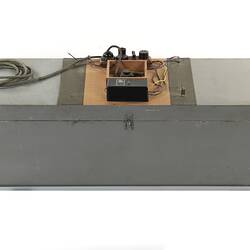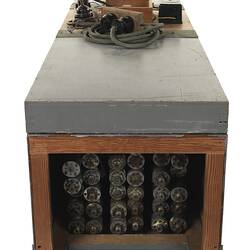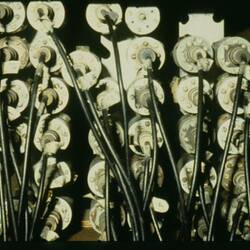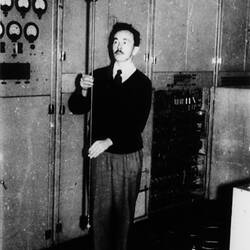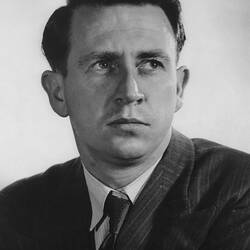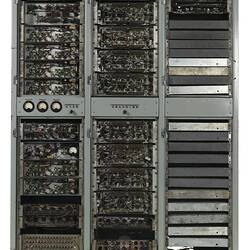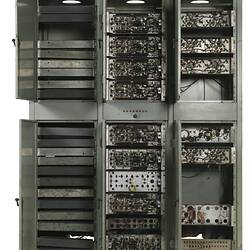Summary
Temperature controlled box for housing memory delay lines for CSIRAC. It was known as the 'hot box'.
CSIRAC's main memory consisted of a temperature controlled box containing 24 mercury delay lines and two cabinets containing control circuitry.
In Sydney originally, the delay lines were not in a temperature controlled box. Sometime before the move to Melbourne, the mercury delay lines were placed inside a temperature controlled box.
The main or primary memory was designed and constructed by Reg Ryan in Sydney. The memory could accommodate up to 32 acoustic mercury delay lines. (There was actually physical space for 48 but the computer could only access 32 electronically). Each line was a five foot long monel metal tube, coated with lacquer and filled with mercury. The mercury filled tubes acted as the medium along which acoustic vibrations passed from a transmitter unit to a receiver unit. These units, known as transducers, consisted of a quartz crystal mounted on a small lead cylinder. In Melbourne, stainless steel delay lines were introduced and were polished inside. It was believed that the lacquer contaminated the mercury, rendering the delay line unusable. Any impurity would affect the contact with the receiving and transmitting transducers.
Even with the internally polished delay lines in Melbourne, mercury would eventually be contaminated. Using a table for handling mercury in the glass blowing workshop of the Physics Department, the delay lines would be emptied of mercury. The lines and crystal transducers would be dismantled and cleaned. The lines would be reassembled and filled with triply distilled mercury. There was no protection against the health hazard caused by mercury. Jurij Semkiw did a lot of this work himself and is responsible for this description.
The delay lines were so called because they delayed the data pulses. Pulses traveled much slower as acoustic signals than they did in electronic circuitry - the data were thus 'stored' because it took a relatively longer time for the data pulses to travel down the tubes compared to an equivalent 'length' in electronic circuitry. The clock (in Cabinet Front 3, Clock & Sequence Control Circuits) ensured that pulses were 'picked up' at the time they were needed for processing.
CSIRAC at Melbourne consisted of two rows of cabinets, a control console, input and output devices, test equipment and an off-line paper tape editing area. There were nine cabinets, five in the front row and four in the back. Cool air was blown up through all the cabinets from the basement below. The auxiliary memory (disk drive) occupied the space that would have been occupied by a cabinet in the back row.
The five front row cabinets contained (viewed from left to right from the front) power supplies, input and output circuitry, clock and control circuits, arithmetical circuits and memory control circuits. The four back row cabinets contained (viewed from left to right from the front) power supplies, auxiliary store control circuits, 'disk drive', auxiliary test power supplies and memory control circuits.
The date range (1954 - 1964) is given to indicate that changes were made to the structure and circuitry over the period of CSIRAC's working life.
More Information
-
Collection Names
-
Collecting Areas
-
Acquisition Information
Donation from Commonwealth Scientific & Industrial Research Organisation (CSIRO), Frank Hirst - University of Melbourne (The), Mar 1965
-
Commissioned By
Commonwealth Scientific & Industrial Research Organisation (CSIRO), Sydney, Greater Sydney, New South Wales, Australia, 1954 or later
-
User
-
Classification
-
Category
-
Discipline
-
Type of item
-
Exhibition Collection Management
1755 mm (Length), 460 mm (Width), 570 mm (Height)
-
References
[Book] McCann, Doug & Thorne, Peter. 2000. The Last of the First CSIRAC: Australia's First Computer. 196., 2000, 9, 32, 54 - 55 Pages
[Book] Doornbusch, Paul. 2005. the music of csirac. 101., 2005
-
Keywords
Computers, Computing, CSIRAC (Computer), Making History - CSIRAC

